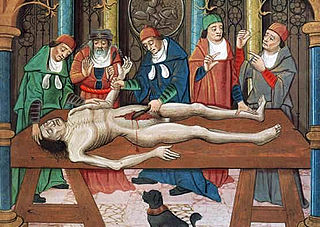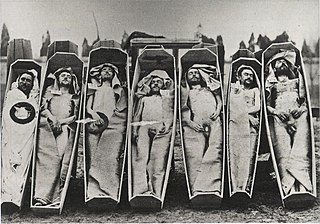Related Research Articles

Anatomy is the branch of biology concerned with the study of the structure of organisms and their parts. Anatomy is a branch of natural science which deals with the structural organization of living things. It is an old science, having its beginnings in prehistoric times. Anatomy is inherently tied to developmental biology, embryology, comparative anatomy, evolutionary biology, and phylogeny, as these are the processes by which anatomy is generated, both over immediate and long-term timescales. Anatomy and physiology, which study the structure and function of organisms and their parts respectively, make a natural pair of related disciplines, and are often studied together. Human anatomy is one of the essential basic sciences that are applied in medicine.

The history of anatomy extends from the earliest examinations of sacrificial victims to the sophisticated analyses of the body performed by modern scientists. The study of human anatomy can be traced back thousands of years, at least to the Egyptians, but the science of anatomy, as we know it today, did not develop until far later. The development of the study of anatomy gradually built upon concepts that were understood during the time of Galen and slowly became a part of the traditional medical curriculum. It has been characterized, over time, by a continually developing understanding of the functions of organs and structures in the body.

The history of anatomy in the 19th century saw anatomists largely finalise and systematise the descriptive human anatomy of the previous century. The discipline also progressed to establish growing sources of knowledge in histology and developmental biology, not only of humans but also of animals.

Mondino de Luzzi, or de Liuzzi or de Lucci,, also known as Mundinus, was an Italian physician, anatomist and professor of surgery, who lived and worked in Bologna. He is often credited as the restorer of anatomy because he made seminal contributions to the field by reintroducing the practice of public dissection of human cadavers and writing the first modern anatomical text.

Dissection is the dismembering of the body of a deceased animal or plant to study its anatomical structure. Autopsy is used in pathology and forensic medicine to determine the cause of death in humans. Less extensive dissection of plants and smaller animals preserved in a formaldehyde solution is typically carried out or demonstrated in biology and natural science classes in middle school and high school, while extensive dissections of cadavers of adults and children, both fresh and preserved are carried out by medical students in medical schools as a part of the teaching in subjects such as anatomy, pathology and forensic medicine. Consequently, dissection is typically conducted in a morgue or in an anatomy lab.

Body snatching is the secret removal of corpses from burial sites. A common purpose of body snatching, especially in the 19th century, was to sell the corpses for dissection or anatomy lectures in medical schools. Those who practised body snatching were often called "resurrectionists" or "resurrection-men". A related act is grave robbery, uncovering a tomb or crypt to steal artifacts or personal effects that had been buried with the deceased; however, grave robbery differs from body snatching in that grave robbing does not involve stealing the corpse itself.

Robert Knox was a Scottish anatomist and ethnologist. He was a lecturer on anatomy in Edinburgh, where he introduced the theory of transcendental anatomy. He is now mainly remembered for his involvement in the Burke and Hare murders. An incautious approach to obtaining cadavers for dissection after the passage of the Anatomy Act 1832 and disagreements with professional colleagues ruined his career. A move to London did not improve matters.
Grave robbery, tomb robbing, or tomb raiding is the act of uncovering a grave, tomb or crypt to steal commodities. It is usually perpetrated to take and profit from valuable artefacts or personal property. A related act is body snatching, a term denoting the contested or unlawful taking of a body, which can be extended to the unlawful taking of organs alone.

The Anatomy Act 1832 is an Act of Parliament of the United Kingdom that gave free licence to doctors, teachers of anatomy and bona fide medical students to dissect donated bodies. It was enacted in response to public revulsion at the illegal trade in corpses.
Gross anatomy is the study of anatomy at the visible or macroscopic level. The counterpart to gross anatomy is the field of histology, which studies microscopic anatomy. Gross anatomy of the human body or other animals seeks to understand the relationship between components of an organism in order to gain a greater appreciation of the roles of those components and their relationships in maintaining the functions of life. The study of gross anatomy can be performed on deceased organisms using dissection or on living organisms using medical imaging. Education in the gross anatomy of humans is included training of most health professionals.
The London Burkers were a group of body snatchers operating in London, who apparently modeled their activities on the notorious Burke and Hare murders. They came to prominence in 1831 for murdering victims to sell to anatomists, by luring and drugging them at their dwelling in the northern end of Bethnal Green, near St Leonard's, Shoreditch in London. They were also known as the Bethnal Green Gang.

A cadaver or corpse is a dead human body that is used by medical students, physicians and other scientists to study anatomy, identify disease sites, determine causes of death, and provide tissue to repair a defect in a living human being. Students in medical school study and dissect cadavers as a part of their education. Others who study cadavers include archaeologists and arts students.
A prosection is the dissection of a cadaver or part of a cadaver by an experienced anatomist in order to demonstrate for students anatomic structure. In a dissection, students learn by doing; in a prosection, students learn by either observing a dissection being performed by an experienced anatomist or examining a specimen that has already been dissected by an experienced anatomist
Night Doctors, also known as Night Riders, Night Witches, Ku Klux Doctors, and Student Doctors are bogeymen of African American folklore, with some factual basis. Emerging from the realities of grave robbing, enforced and punitive medical experimentation, and intimidation rumours spread maliciously by many Southern whites, the Night Doctors purpose was to further prevent slaves, Free Men, and black workers leaving for the North of the United States, in a prescient foreshadowing of the inevitable events during the early to mid 20th century, now known as The Great Migration.
An anatomy murder is a murder committed in order to use all or part of the cadaver for medical research or teaching. It is not a medicine murder because the body parts are not believed to have any medicinal use in themselves. The motive for the murder is created by the demand for cadavers for dissection, and the opportunity to learn anatomy and physiology as a result of the dissection. Rumors concerning the prevalence of anatomy murders are associated with the rise in demand for cadavers in research and teaching produced by the Scientific Revolution. During the 19th century, the sensational serial murders associated with Burke and Hare and the London Burkers led to legislation which provided scientists and medical schools with legal ways of obtaining cadavers. Rumors persist that anatomy murders are carried out wherever there is a high demand for cadavers. These rumors, like those concerning organ theft, are hard to substantiate, and may reflect continued, deep-held fears of the use of cadavers as commodities.

Resurrectionists were body snatchers who were commonly employed by anatomists in the United Kingdom during the 18th and 19th centuries to exhume the bodies of the recently dead. Between 1506 and 1752 only a very few cadavers were available each year for anatomical research. The supply was increased when, in an attempt to intensify the deterrent effect of the death penalty, Parliament passed the Murder Act 1752. By allowing judges to substitute the public display of executed criminals with dissection, the new law significantly increased the number of bodies anatomists could legally access. This proved insufficient to meet the needs of the hospitals and teaching centres that opened during the 18th century. Corpses and their component parts became a commodity, but although the practice of disinterment was hated by the general public, bodies were not legally anyone's property. The resurrectionists therefore operated in a legal grey area.

The doctors' riot was an incident that occurred in April 1788 in New York City, where the illegal procurement of corpses from the graves of the recently deceased caused a mass expression of discontent from poorer New Yorkers that was directed primarily at physicians and medical students.
The Pennsylvania Anatomy Act of 1883 is legislation of the State of Pennsylvania to facilitate medical education. This act allowed teachers and students to be able to dissect bodies without have to resort to buying from grave robbers or buying body parts. This act was written to prevent grave robbing, and to even out the availability of corpses.
As anatomy classes in medical education proliferated in the 19th century, so too did the need for bodies to dissect. Grave robbery proliferated, along with associated social discontent, revulsion, and unhappiness. Conflicts arose between medical practitioners and defenders of bodies, graves and graveyards. This resulted in riots. Social legislation was passed in many countries to address the competing concerns.
The Law of 1794, derived from the Fourcroy Report of 1794, was enacted by the National Convention in December, 1794 in Paris, France. The law, stemming from a report from Antoine François, comte de Fourcroy, proposed the reorganization of the structure of medical education in post-revolution France and sought to lay the ground work for the institution of Hospital Medicine in France.
References
- Oshinsky, David (2016). Bellevue: Three centuries of medicine and mayhem at America's most storied hospital. Doubleday. ISBN 9780385523363.
- Sappol, Michael (2002). A traffic of dead bodies: Anatomy and embodied social identity in nineteenth-century America. Princeton University Press. ISBN 9780691059259.